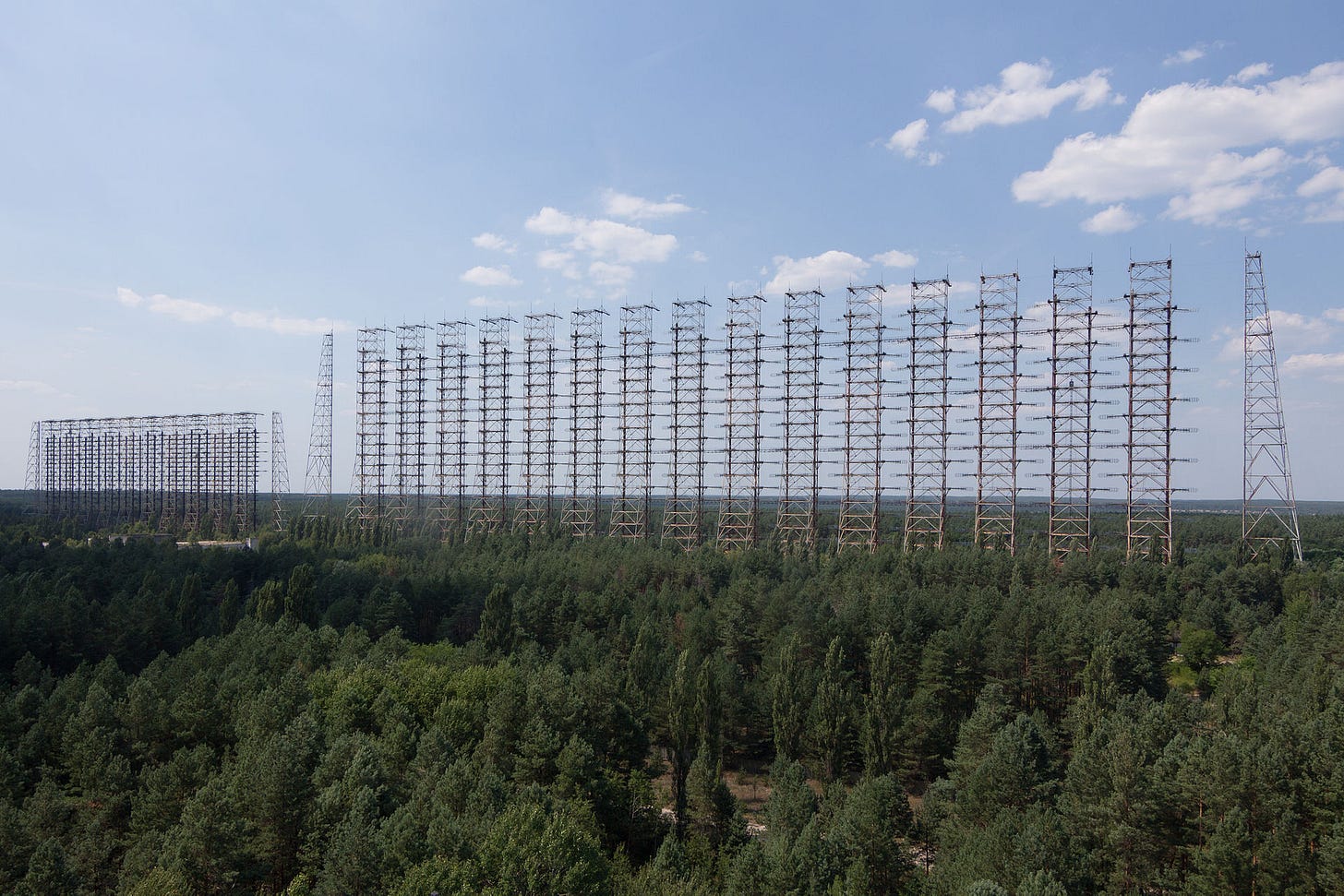Evian Christ: Duga-Three
A singular entry in the UK trance revivalist's discography
I left my job as the editor of a hip-hop magazine in the summer of 2013.
As Rick Rubin once put it, I’d “burned out on rap”.
I’d never been a purist, but rap was one of the most important musical influences since my youth. More than anything though, I loved beats – hip-hop beats, instrumental beats, electronic beats, glitchy beats, wonky beats, moody beats.
In the early 2000s, my favorite hip-hop producers were Madlib, Dilla and DOOM, and then I discovered Flying Lotus and the L.A. beat scene, which seemed to bridge the gap between hip-hop and electronic music. I was also still following UK club music, especially the ‘post-dubstep’ strain, and discovered the chillwave genre and hypnagogic pop, both precursors of vaporwave.
As I got deeper into the electronic side of things, rap became less interesting to me. I also felt increasingly alienated by the inherent machismo and misogyny in hip-hop culture. Last but not least, my rap burn-out was fueled by having to deal with a lot of outsized egos in that scene on a professional level.
It was 2012 when I discovered a piece of music that would prove extremely influential for me, while failing to generate much interest on a broader scale. This was a 20-minute concept composition based on a shortwave radio signal called the ‘Russian Woodpecker’. It sounded weird and dark and interesting, and most of all, it was beatless.
While Duga-Three marked completely new territory for Its creator, a young North English beat producer by the name of Evian Christ, it felt like I was entering a whole new musical universe too. I listened to this piece obsessively for months.
When music magazine Dummy reached out to Joshua Leary, alias Evian Christ, to hand in a bespoke mix for their website, the 22-year old producer from a small town near Liverpool was known for hard-hitting electronic beats with a trap and dancehall edge.
The aspiring teacher had just released his critically acclaimed instrumental mixtape Kings And Them, was freshly signed to Tri-Angle records, then one of the most daring labels in the world of underground electronic music, and was rumored to contribute to Kanye West’s upcoming Yeezus album (he would actually land co-production credits on one song).
But when the editors at Dummy received his “concept mix”, it must have left them dumbfounded.
Instead of a DJ mix, Leary delivered a 20-minute piece of original music consisting mostly of a throbbing noise, drones, static and Russian-speaking voice samples.
A short artist note on the composition read:
“Duga-three is a four-part piece of music I wrote after reading about a Soviet signal transmitter of the same name. It was characterised by the repetitive tapping sound it broadcast, which was sufficiently powerful enough to intercept transitions across the world. After 28 years of transmission, the Duga-3 array was abandoned as mysteriously and unexpectedly as it had appeared.”
As Leary confirms here, Duga-Three is built around samples of the ‘Russian Woodpecker’. This static radio signal was transmitted from the Soviet Union during the cold war, starting in the 1960s.
At first, nobody knew where it came from, so it became subject to much speculation. In the 1970s, Western authorities found out that it was broadcast by a huge over-the-horizon radar, probably part of the USSRs early defense missile warning system. During the disintegration of the Soviet state in the late 1980s, the signal eventually disappeared from radio waves.
In fact, the title of Learys composition might be a bit misleading, as only two Duga radars exist – Duga-1, located near Chernobyl and Chernihiv, Northern Ukraine, and Duga-2 in Eastern Siberia. (The original Duga radar, which had been built in Southern Ukraine, was demolished.) The term Duga-Three most likely refers to Station 3 of Duga-1, which is the one near Chernobyl.
These days, the Duga-1 radar remains a large, abstract-looking ruin within the Chernobyl exclusion zone. You can find videos online by people who illegally climbed it, or waded through its abandoned control rooms.
Near the radar ruin, visitors stumbled across a huge underground complex that was apparently used for military research, surveillance, communication, and defense.

However, not much is known about the mission of the Duga radar and the ‘Russian Woodpecker’ signal.
The level of secrecy around it spawned several conspiracy theories. A celebrated 2015 documentary by director Chad Gracia even suggests the Chernobyl nuclear disaster was intentionally initiated by Moscow’s higher-ups to cover up technical problems with the radar.
The story fascinated Evian Christ enough to write a whole piece around its tapping shortwave noise.
Still, what’s at least as interesting as the backstory is the music itself. It didn’t bear much resemblance with the beats on Leary’s breakout mixtape. In an interview about the piece for Dummy, the producer mentioned being really into experimental music at that time.
“I had been listening to a lot of old Tim Hecker, Kane Ikin, Ezekiel Honig, Wanda Group. I’m also really into this Swedish guy called 1991 who makes really amazing grainy lo-fi sort of stuff, and Lukid also makes some crazy music along similar lines.”
In 2012, I had not heard anything about these artists, but Leary’s statement made me research their discographies.
Duga-Three also referenced the techniques of more academic styles of music like musique concrète. Technically, Leary employed montage techniques, using recorded sounds as raw material, processing and looping specific parts of the recordings in music production software Cubase.
As he mentioned in his blurb, his composition can be roughly divided into four parts which seamlessly blend into one another, their transitions usually marked by the introduction of a new element, for example the characteristic synth drone or the unintelligible, Russian-speaking voices that stay with the listener almost until the end.
To be very clear, this is no feel-good ambient providing an innocuous backdrop for studying or hanging out. On the contrary, Duga-Three conveys an uneasy atmosphere, dark and unsettling, but strangely fascinating.
The composition was first released on Dummy’s Soundcloud page in 2012, to little fanfare. Until today, it hasn’t been played more than 10,000 times, and only received a handful of comments. I think of this as a sign that it really went over people’s heads, at that time more than ever.
For Record Store Day 2013, Learys new label Tri-Angle pressed up a one-sided LP in a limited edition of 500. These days you can scoop up a mint condition copy for a couple of pounds or euros on Discogs.
In the aforementioned interview about the piece for Dummy, he describes it as a “one off”.
In 2014, he produced a second EP for Tri-Angle, which seemed to combine his love for instrumental hip-hop and dancehall beats with his interest in more experimental sounds.
Leary’s career would then pivot towards DJing. He became one of the key drivers of the ongoing trance revival in electronic music. throwing popular trance parties across the UK and occasionally co-producing beats and remixes for artists like Danny Brown, Bladee or Travis Scott.
For now, Duga-Three stands as an outlier in his discography – but one that deeply influenced me and led me into a world of music I wasn’t interested in much before.
It might seem like a random piece of experimental electronic music from the early 2010s. But it completely changed the way I looked at music and made me start researching minimal and avant-garde music, musique concrète and electroacoustic composition. I also got really deep into drone music, and discovering a love for beatless music.
I still listen to the piece once a year, and I think it has aged really well. I also still regularly search the internet about new conspiracy theories on the Duga radars.
I guess you could rightfully say that without Duga-Three, this newsletter probably wouldn’t exist – at least not in its current form.
Editor’s note: This piece was written and first published in December 2022. In October 2023, Evian Christ released his long-awaited debut album Revanchist on Warp. It does not feature any music even remotely resembling Duga-Three. I made some slight edits to the piece to reflect his artistic development.


